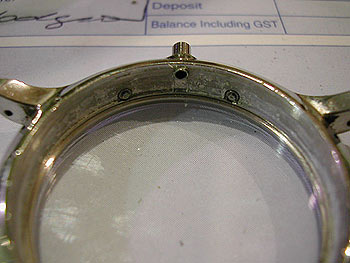On the next morning, the Zenith was only half reassembled when another ‘sea monster’ presented itself in the form a of a Jaeger-LeCoultre Master Control triple date, moon phase. ‘Money is not an issue’ - said the owner. ‘I just need it back as soon as possible’. The wretched thing looked like a dying starfish and the stained job envelope smelled of chlorine.

Before we go any further, let me get straight to the point: there is no such thing as a WATERPROOF watch!

OK, I know you have one and it is engraved on the back "Water resistant to infinity and beyond". Maybe it is a 10 year old gold Rolex Submariner that cost $20K, one you wear around your yacht and use occasionally as a scuba diving watch.
Fine, I can't wait to see it in my workshop!
The truth of water resistance is the best keep secret of the watch industry. It is the Holy Grail of watchmaking, a myth perpetuated by the Holy Trinity consisting of 1. greedy watch manufacturers 2. unscrupulous sales people 3. ignorant watch owners.
Sure enough, SOME watches are capable of surviving when submerged under water but this rarely has anything to do with a/ how much you’ve paid for it or b/ the declared rating engraved on the case or printed on the watch dial. It's all about engineering, manufacturing and maintenance and nothing about money, marketing and sales pitch.
Let me give you an example. I drive the smallest Holden car on the market, a four door, 1.4 litre Barina. It is a great little car to take you from A to B, unless you take Holden's speedo readings for granted. Some innocent and naive passenger can actually BELIEVE that the car is capable of doing 200 KM per hour. My five year old boy for instance. But as a driver, you KNOW this car can only reach the maximum speed of 140 km/h downhill or safe 100 km/h on the motorway. Or 70km/h if you want it to last for 10 years.
It is the same with watches. Unless each and every single contact surface between case parts is sealed properly, you can dismiss what's written on the dial. Secondly, even if your watch is water resistant, it's only capable of resisting to a certain degree and under certain conditions (e.g. depth, static pressure, temperature). Thirdly, your watch may be water resistant today and not tomorrow - regular maintenance of water related properties is essential.
Without going into too much detail and being too technical, let me just say this- there are at least 3 important contact areas in your watch that could 'leak' - glass to case, case-back to case and winding crown to case. Most common materials used as sealant are rubber and teflon. Under normal circumstances, the lifetime of a crown rubber seal is 3-5 years. And water couldn’t care less how well-sealed your glass is - if your crown or case seal is no longer doing its job, the water will follow the path of least resistance.
Another myth is "rust-free-stainless-steel". Next time you go to a marina, take a closer look at those fancy ( and expensive) stainless fittings. Acid, sweat, salt water, moisture, sand and dirt will eat into finely-machined steel. The same problems apply to your watch case. Even if you replace all seals religiously every 3-5 years, it is very likely that after 20 years of constant use the watch is simply no longer capable of being sealed properly - regardless of who does the job: be it your 'mall watch kiosk guy' or Swiss service centre using a SFR100000 water pressure tester.
If you really need to tell the time under water, the bare minimum is a watch with a screw-lock winding crown and screw lock case back. Snap-on case back will not do the trick.
Most TAG watches are fine for swimming if rated "200m" as long as they have screw lock crown and case back. New Rolex Datejust and GMT Master are fine for accidental submerging, but I would not swim with one unless I'm running for my life. Rolex Submariner is the way to go - robust and truly waterproof watch. Or better still if you need a tool watch go for a Rolex Seadweller.
Panerai, Jaeger Le-Coultre, IWC and other high grade watches are too precious to be worn under water under any circumstances. Most Omegas, Longines and Breitlings are too fragile even for normal, every-day use.
Of course in order to preserve water-related properties, all above-mentioned watches would need water pressure testing every 12 months and complete case overhaul every 2-3 years. After 15 or 20 years of use they should go into a well-deserved retirement and should no longer be taken into water.
The following are watches that can never be worn under water, regardless of manufacturers "approval"
- gold or two-tone watches
- chronograph and other complicated watches
- multi-pusher digital watches
- any vintage watches or watches over 15-20 years old
- any timepiece attached to a leather strap
Finally - do not wear your watch in the shower. Watches are designed for cold water only. After swimming, rinse your divers watch under tap. Have the case and bracelet cleaned every 12 months. Do not expose to direct sunlight or heat. Use common sense and submerge only if you really have to. Do not be fooled by brand / model names like “promaster, diver, seamaster, shower-proof” - very often this is just another advertising gimmick.
Quite frankly, I would rather wear a $50 Casio in the surf than a $5K Seadweller – If I had time to surf!

No comments:
Post a Comment